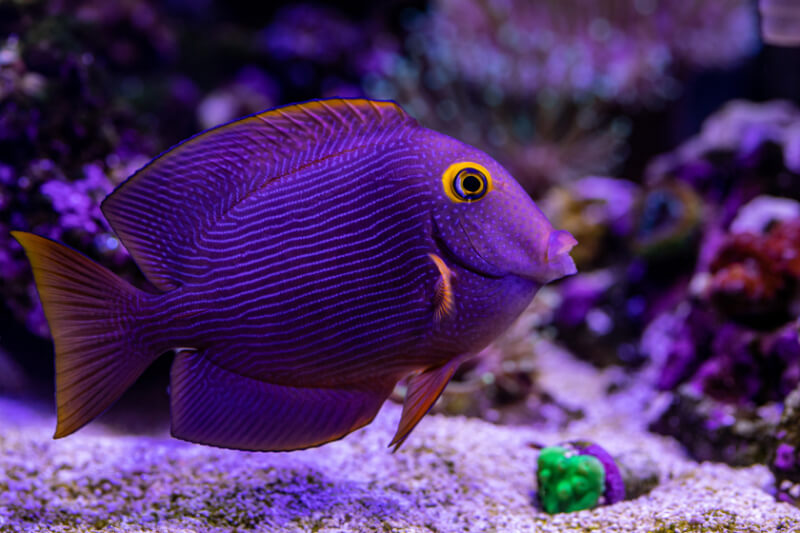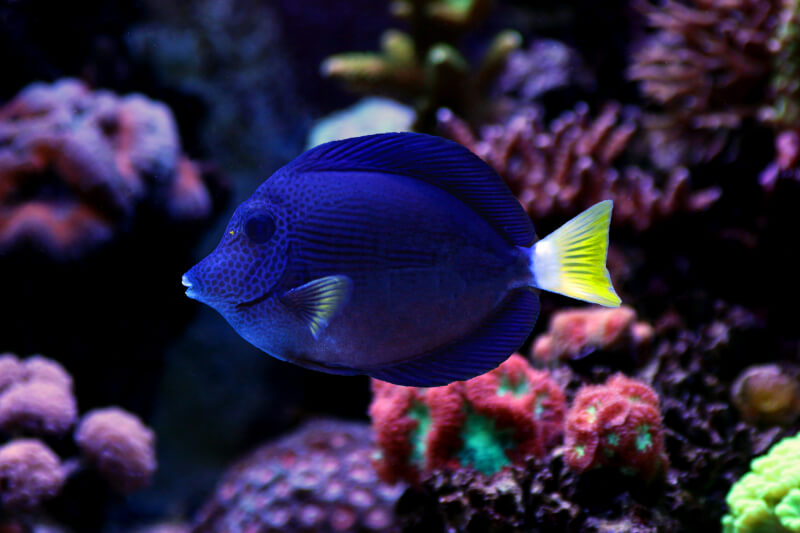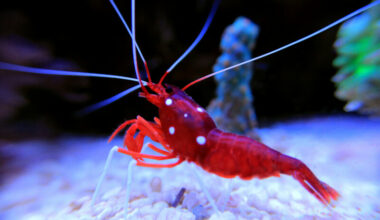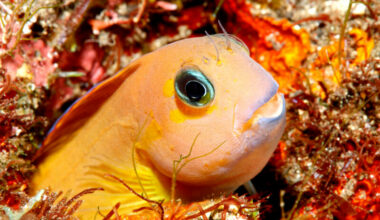Deciding which tang to add to your saltwater aquarium is a difficult task due to the many great options out there which is why we created this guide.
Tangs or surgeonfish are known for their striking and diverse coloration. From electric blues and vibrant yellows to deep greens and even purples, their hues make them an eye-catching presence on coral reefs
Many tangs and surgeonfish have a specialized diet of algae and plant material. This herbivorous feeding behavior plays a crucial role in controlling algal growth on coral reefs and maintaining the health of these delicate ecosystems.
Let’s get started so you can choose on your own which tang (or tangs) are best for you!
1. Doctorfish Tang
Doctorfish Tangs, or Acanthurus chirurgus, are known for their beautiful colorings and mesmerizing behaviors. They’re named for the “scalpels” you can spot near the caudal peduncles. They use these to ward off predators and other potential threats. These surgeonfish are found in the Atlantic Ocean near places like Brazil as well as in the Mediterranean Sea.
Author Note: Doctorfish Tangs live in the reefs at depths of up to 82 feet. While they can be happy alone, they’re most often spotted in pairs or groups of juveniles.
It’s important to note that Doctorfish Tangs can display territorial behaviors. Proper tank acclimation is key to ensure they’re happy and stress-free. Provide plenty of cave structures and hiding spots that they can explore during the day. Rather than sleep out of sight, they’ll instead choose to rest in the coral or along the sand at night.
Lifespan: 16 to 27 years
Tank Size: 100 gallons minimum
Difficulty: Intermediate
Size: 10 to 11 inches
2. Kole Tang
The peaceful Kole Tang is also called the Bristletooth Tang or Yellow-Eyed Tang. The Ctenochaetus strigosus can be found in the Pacific Ocean around the Philippines and the Hawaiian Islands. They’re smaller than other tangs and tend to be much less aggressive. However, they also share many similarities with their relatives like their natural algae grazing tendencies.
Appearance Facts:
– They are flat, oval-shaped and boast a sharp scalene spike that protects them from harm.
– Much of this fish’s body is brown while their pectoral fins are a striking orange or yellow.
– Their eyes are also highlighted in yellow, and they have thin body stripes.
– The older these fish become, the more their natural coloring stands out.
Like other tangs, discerning a male from a female can be difficult, which often makes breeding in captivity impossible. Fortunately, they’re easy to find in stores and get along great with other saltwater fish. Giving them plenty of room to explore, graze and swim will keep them healthy and limit bullying and potential aggression.
Lifespan: 6 to 10 years
Tank Size: 75 gallons minimum (check our 75 gallon fish tank guide)
Difficulty: Intermediate to Hard
Size: Up to 7 inches
3. Mimic Tang
The Acanthurus pyroferus, or Mimic Tang, is primarily found in the Indo-Pacific Sea. Their usual territory stretches from the Great Barrier Reef to Japan’s southern coast. These surgeonfish are most active during the day and will come out of hiding to feed about three times daily. Other names for this fish include the Chocolate Tang and Lemonhead Mimic Tang.
Appearance Facts:
– These exciting herbivorous fish are considered mimics because as juveniles they take on the coloring of angelfish.
– They can have a variety of color variations at this age and will only be identifiable as tangs due to their body shape.
– Their eye markings can range from bright yellow to red, and their dorsal fins may have prominent green or yellow highlights.
– These fish thrive by adopting the look of other marine life in their immediate area.
Mimic Tangs are great for beginning aquarists as long as you pay special attention to their water quality. They need to be well-fed and kept in a large tank that’s properly oxygenated. All water changes should be completed slowly as these tangs are sensitive to sudden oxygen or salinity drops.
Lifespan: 8 to 10 years
Tank Size: 90 gallons minimum
Difficulty: Easy
Size: Up to 10 inches
4. Orange Shoulder Tang
The reef-loving Orange Shoulder Tang is native to the Pacific Ocean and the coasts of Hawaii and Polynesia. Their scientific name is Acanthurus olivaceus, but they’re also referred to as Orange Band Surgeonfish and Orange-Epaulette Surgeonfish. This fish is easily frightened, which is why they generally prefer to stay within the cover of the reef.
This fish is one of the more popular tangs for hobbyists as they’re generally considered incredibly hardy. Whether you’re a beginner or an expert, you should still handle these fish with care to avoid being pricked by the “sword” on their tail. Unlike other tangs, these surgeonfish have a relatively muted coloring.
Appearance Facts:
– As juveniles, they have slim yellow bodies and light orange markings along the shoulders.
– Once they reach adulthood, they develop two-tone bodies that have a blend of gray and blue. In certain lighting, you may see a faint brown or olive shade coming through.
– The orange around their shoulders becomes more noticeable thanks to a dark surrounding ring.
These omnivorous tangs are picky with their surroundings, so be sure to use a soft substrate and offer an abundance of hiding crevices. They’re mildly aggressive but tend not to start fights if they’re properly fed. While this fish is an egg scatterer like other tangs, there have currently been no successful attempts at breeding in captivity.
Lifespan: 10 to 15 years
Tank Size: 135 gallons minimum
Difficulty: Intermediate
Size: Up to 14 inches
5. Gem Tang
The Gem Tang or Spotted Tang is a high-end saltwater fish from the Indian Ocean. Zebrasoma gemmatum are naturally curious and active swimmers with disc-shaped bodies. These fish have a reputation for showing hostility toward other vertebrates introduced to the aquarium.
Author Note: Gem Tangs are one of the most expensive fish available, with many costing upwards of $1,000 each.
Gem Tangs thrive best in a tank with LED lighting and a good filtration system. They’re messy eaters and can easily leave scraps around the tank that drop your water quality. While they’re primarily herbivores, it’s helpful to balance their diet with some added protein-rich foods.
Part of the reason why these fish are so costly is because they’re difficult to find in the wild and safely transport. Gem Tangs, like other surgeonfish, are also notoriously hard to correctly sex and breed.
Lifespan: 7 to 10 years
Tank Size: 180 gallons minimum
Difficulty: Intermediate
Size: Up to 8.7 inches
6. Sohal Tang
The stunning Sohal Tang, otherwise known as the Arabian Tang or Sohal Surgeonfish, is a tropical fish that lives in sandy areas and coral reefs up to 100 feet deep. They’re originally from the portion of the Indian Ocean between the Persian Gulf and the Red Sea.
Author Note on Diet: The Acanthurus sohal needs a nutrient-rich diet of pellets, flakes and vegetables to keep them energized. You’ll also have to feed them three to four times a day and provide nutritious snacks like dried seaweed.
For these surgeonfish, it’s best to have a tank that’s at least eight feet long. This gives your Sohal plenty of room to swim and lowers the chances of bullying. As they’re incredibly active swimmers, it’s also important to give your other fish room to hide. Consider opting for peaceful tankmates of about the same size for ideal results.
Breeding Sohal Tangs is a complex and arduous process that requires a lot of resources and research. Most of these tangs available in stores are wild-caught rather than captive-bred. While this species does mate for life, it’s hard to keep more than one happy in a single aquarium. Even in the wild, the rate of larvae survival is low and many don’t make it into adulthood.
Lifespan: 15 to 20 years
Tank Size: 250 gallons
Difficulty: Easy to Intermediate
Size: Up to 16 inches
7. Powder Brown Tang
A Powder Brown Tang Acanthurus japonicus is different from others in its species due to its energetically helpful tank cleaning habits. This surgeonfish calls the lush reefs and lagoons in the Western Pacific their home. They especially like the warm waters near Taiwan, the Philippines and Japan. You only have to dive down about 16 to 25 feet to find these charming surgeonfish swimming in schools in the clear water.
Powder Brown Tangs are only semi-aggressive, which makes them one of the more passive tang species. Called Black Powder Surgeons or Japanese Surgeonfish, these fish are constantly active, herbivorous and semi-difficult to successfully keep.
Appearance Facts:
– They’re mainly brown but your tank’s lighting may bring out a gray tone.
– Look closely to see a white smudge starting below their eyes and stretching down to their mouth.
– They also have yellow bands on top of their body. Their dorsal, pectoral and anal fins are brown with a bright blue edge.
– The tailfin is blue and brown and has a sharp point.
While Powder Brown Tangs do have the trademark defensive spine, theirs is not as prominent as those on other surgeonfish.
These tangs love algae, especially benthic algae, and will scour your live rock for any marine plants or growths. To keep them well-fed, you may want to consider starting a refugium to ensure you have a constant supply. Many recommend using a feeding clip for these fish to mimic their instinctual grazing habits.
Lifespan: Up to 7 years
Tank Size: 125 gallons minimum
Difficulty: Intermediate
Size: 8 inches on average
8. Chevron Tang
The Ctenochaetus hawaiiensis or Chevron Tang is a rare species found in the Pacific Ocean. Referred to as Black Surgeonfish or Chevys, they live in various habitats around Hawaii down to depths reaching 200 feet. The juveniles will often stick to deeper coral areas while the adults are happier in the rocks near the surface. These surgeonfish start as loners, but most will spend their adulthood in a group or a mated pair.
Author Note: They’re moderately active and undergo several color changes as they age. Chevron Tangs are best suited to community aquariums as their toned-down colors provide an exceptional contrast for other bolder fish. Chevys are different from other Tangs in that as they age, their coloration becomes more dull.
Appearance Facts:
– They start as brilliant orange-red fish with vibrant blue or purple V-lines.
– The adults, on the other hand, are black with green V-shapes that can only be seen with a careful eye. This transition occurs as a defense mechanism.
– Bright colors help the juveniles to better camouflage themselves in the coral.
Older Chevys live amongst the rocks where darker shades are safer. This color change starts once the tang reaches about three inches long. Another fascinating feature of these surgeonfish is their 30 teeth that they use to scrape algae.
Lifespan: Up to 15 years
Tank Size: 150 gallons minimum
Difficulty: Intermediate to Hard
Size: 11 inches on average
9. Clown Tang
The scientific name for the Clown Tang is Acanthurus lineatus. They’re native to the Indo-Pacific waters between Hawaii and Africa’s east coast. These Striped Tangs or Lined Surgeonfish can live up to 50 feet deep but spend most of their time around three to 10 feet below the surface. Clown Tangs are exclusively wild-caught, which means they can be needy and are better suited to experienced aquarists.
Appearance Facts:
– The defining trait of these surgeonfish is their pigmentation.
– The majority of their bodies consist of alternating blue and yellow stripes edged with black.
– A small portion of the fish is a light purple or a shade of bluish-white.
– Clown Tangs have small mouths, short snouts and tiny, spatula-shaped teeth.
These fish are more prone to roaming than diving, meaning it’s better to opt for a longer tank than a tall one. You don’t want to overcrowd your aquarium as they need plenty of room to swim. Be sure to use a tight-fitting lid to stop them from getting out. Start by feeding your Clown Tang twice a day, altering the overall amount based on their consumption as they adjust to tank life.
These charming surgeonfish are generally calm and peaceful as juveniles. Their aggressive streaks start to emerge at around six inches. They’ll become more confrontational with age and have even been seen chasing their tankmates away.
Lifespan: 10 years on average
Tank Size: 250 gallons minimum
Difficulty: Hard
Size: 12 to 14 inches long
10. Purple Tang
Purple Tangs, which also go by Blue Surgeonfish or Yellow-tail Surgeonfish, are typically more expensive than other surgeonfish. The majority of Zebrasoma xanthurum live in the Red Sea, but others can be found in the Gulf of Aden and the Persian Gulf. They typically only swim to depths of about 65 feet to eat and breed.
Appearance Facts:
– Just as their name suggests, these surgeonfish possess purple bodies.
– It’s possible but rather uncommon to see tangs in dark blue or even indigo shades.
– They also have yellow tailfins and pectoral fins tipped with yellow.
– Small black dots create thin lines down their flanks that can be nearly impossible to see.
Their brilliant coloring will quickly fade if they’re stressed or sick.
Author Note: These feisty, reef-safe fish are particularly interested in feasting on the hair algae that can be hard to control once it starts spreading amongst your corals. Due to their higher cost and natural aggression, it’s recommended to only raise one per tank.
Home breeding of this species is next to impossible. Since they’re broadcast spawners, their mating process includes both the male and female releasing the eggs and sperm respectively into the water. These materials will bind in the current and result in fertilization. Even with the use of massive commercial tanks, it’s still difficult to accurately sex the tangs and consistently prompt successful breeding efforts.
Lifespan: Up to 10 years
Tank Size: 100 gallons minimum
Difficulty: Intermediate
Size: 8 to 10 inches
Wrapping Up
Now you are ready to pick a tang for your saltwater aquarium! Tangs or surgeonfish are a great addition due to their colorful patterns and even color change attributes that some of them have. If you are worried about reef safety then these fish seal the deal as the perfect choice.
Depending on how much space you have, some tangs are quite big and require large aquariums not only to have enough space to swim, but also to hide and to control their aggressiveness which usually happens in crowded tanks.
We hope this guide provided you with everything you needed to succeed in this fishkeeping journey, and if you have any questions do not hesitate in reaching out to us. Don’t forget to tag us on Facebook when sharing cool photos of your tangs and if you are looking for more information try our Saltwater Fish Care Guides.
Good luck!











